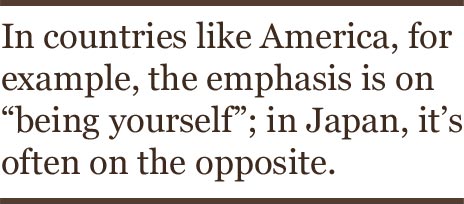I walked into the center of old Kyoto not long ago and found myself in a scene from a Hiroshige painting. Huge floats containing ancestral treasures stood on the narrow lanes at the heart of the ancient capital, while rows of lanterns bobbed above the wooden houses. Old men played piercing melodies on bamboo flutes, and little boys, wearing blue headbands to match their yukata, or cotton kimono, thumped away on drums. Along the Kamo River, which runs through the “Moon Capital” like a lifeline, couples were seated on wooden platforms under the stars, red lanterns (with white plovers on them) lighting up their faces as in a novel by Yasunari Kawabata. Even at the busiest intersections, women in indigo kimono were standing, picture-perfect, under parasols.
 Yet when the floats began to move through the busy streets, in the great summer festival of Gion Matsuri, I started to notice other things below the classic surfaces. Many of the men in white-and-blue yukata, chanting a traditional song in unison, had the dragon tattoos of gangsters across their bare chests. Many of the young women running after them were teetering on 8-inch platform heels, their hair bright yellow and their skins artificially tanned in the fashion of the moment. Even some of the tiniest little boys were calling their mothers on tiny cell phones. The ancient rites were observed solemnly, with dignity and elegance; but they were woven into and around and through the most garish of modern Western artifacts. As if (as often happens) a geisha were carrying a boom box into a traditional inn.
Yet when the floats began to move through the busy streets, in the great summer festival of Gion Matsuri, I started to notice other things below the classic surfaces. Many of the men in white-and-blue yukata, chanting a traditional song in unison, had the dragon tattoos of gangsters across their bare chests. Many of the young women running after them were teetering on 8-inch platform heels, their hair bright yellow and their skins artificially tanned in the fashion of the moment. Even some of the tiniest little boys were calling their mothers on tiny cell phones. The ancient rites were observed solemnly, with dignity and elegance; but they were woven into and around and through the most garish of modern Western artifacts. As if (as often happens) a geisha were carrying a boom box into a traditional inn.
When first I came to Japan, more than 20 years ago, these contradictions—and the serenity with which the culture lived among them—startled me every day. If the test of a first-rate mind, as Scott Fitzgerald once wrote, is the ability to hold two opposed ideas at the same time, and still keep going, then Japan, I thought, had the best mind I’d encountered in a lifetime of traveling. And in the years that have followed, the extremes have in some ways intensified, as much of Japan streaks into a mongrel, high-tech, science fictive future, while the rest remains more firmly rooted in the old than any culture that I know, including China’s. There are TVs on the dashboards of taxis in Kyoto, but most Japanese people were slower to get onto the Internet than the people of Cambodia were.
As I’ve stayed longer in Japan, though, living here on and off for almost a decade, I’ve come to think that contradiction is in many ways in the eye of the beholder, and that part of the magic of this place is that it invites, and sometimes forces the foreigner to leave, his assumptions at home. We tend to think that cultures, and people, must be one thing or the other (modern or traditional, themselves or imitations, elegant or crude); the Japanese are happy to see them as both things simultaneously. They adhere, that is, to a belief in both/and more than in either/or. And this allows them to collect an almost indefinite number of selves and surfaces without remaining any less themselves within: at a typical wedding over here, the bride still changes costume three or four times in a day, shifting from classic Shinto maiden to white-dress Eastern Cinderella to typical Japanese young woman (with many traditions alive in her).
This is, of course, a skill prized in all ritualized old societies—it’s little different from the England where I was born—but nowhere is it managed so efficiently as in Japan. In countries like America, for example, the emphasis is on “being yourself”; in Japan, it’s often on the opposite. Being “not yourself,” but just a kind of impersonal actor playing the part the moment requires (to this day my Japanese wife doesn’t know the name of her immediate boss at work, because the boss is always and only known as “Tencho,” or “Department Head”). And this is all made easier, perhaps, by the fact that the Japanese tend, I believe, to think in images rather than in ideas, and where ideas need to be consistent, images can sit side by side, belonging to different worlds, like parallel lines in a haiku. It’s not uncommon, near where I live, to see a Zen abbot stepping out of a late-model Mercedes, on his way to his favorite bar in the red-light district. In Europe, such behavior might be seen as hypocritical; in pragmatic Japan, a Buddhist priest will perform every last rite demanded of him at funerals and ceremonies immaculately—like the Platonic image of a Buddhist priest; but when he is finished, he will go home to his wife and children, and pop open a beer in front of the baseball game on TV. He’s played his role, he’s allowed to slough off his robes.

Explore Related Articles

